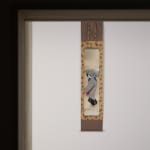Itō Shinsui (1898−1972)
Snow
Color and gold on silk, hanging scroll
With a box signed by the artist, double boxed
Seal: Shinsui
121.5 x 27.4 cm
203 x 40 cm (overall)
Further images
Both the composition and atmosphere of this work are representative of Ito Shinsui’s beauty with an umbrella, which is a frequent motif of the artist. With an umbrella tightly griped in both hands, the lady staggers against the strong wind, while carefully watching out for the slippery ground. The wind is so severe that even the snow that falls on the umbrella are soon blown away. Shinsui made his observation to the smallest detail—even the snow remained between bones of the umbrella due to its half-opening is well-represented. The vermillion of the yagasuri (arrow feather) pattern of her kimono and the purple of her geta strips display a sense of gracefulness reflecting her good upbringing. At a first glance, this work depicts the freezing midwinter scene. However, details such as the plum blossom and willow patterns on the lady’s coat are signs of the coming spring. Moreover, the red foliage pattern on the opening of her kimono might be a symbol of autumn, suggesting the flow of seasons from autumn to winter, and to spring.
Ito Shinsui (nihonga painter; 1898−1972)
Tokyo-born nihonga painter. His real name is Hajime. Studied under Kaburaki Kiyokata. Exhibited at Bunten and Teiten. His works, Hago-no-oto and Akibare, were given tokusen (special prize that grants entry without examination in the following year) at the eighth and the tenth Teiten respectively. Became one of the greatest Bijinga (painting of beauties) artists. Established an artistic style based on the ukiyo-e tradition while adopting the modern genre scene. Consultant to Jitsugetsu-sha and Nitten. Member of the Japan Art Academy.
Ito Shinsui (nihonga painter; 1898−1972)
Tokyo-born nihonga painter. His real name is Hajime. Studied under Kaburaki Kiyokata. Exhibited at Bunten and Teiten. His works, Hago-no-oto and Akibare, were given tokusen (special prize that grants entry without examination in the following year) at the eighth and the tenth Teiten respectively. Became one of the greatest Bijinga (painting of beauties) artists. Established an artistic style based on the ukiyo-e tradition while adopting the modern genre scene. Consultant to Jitsugetsu-sha and Nitten. Member of the Japan Art Academy.









